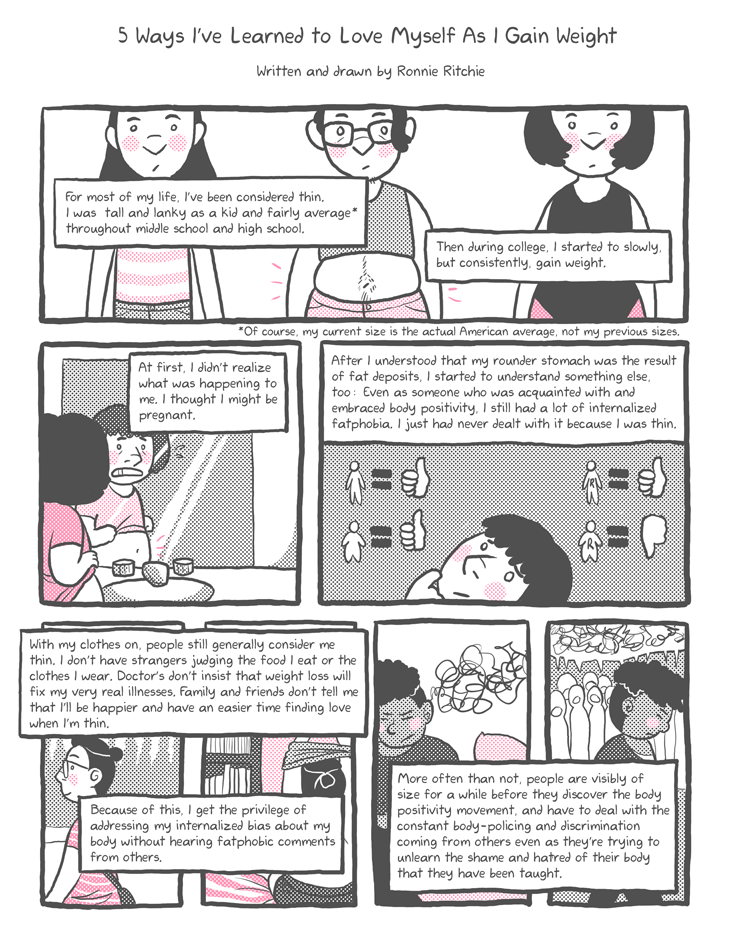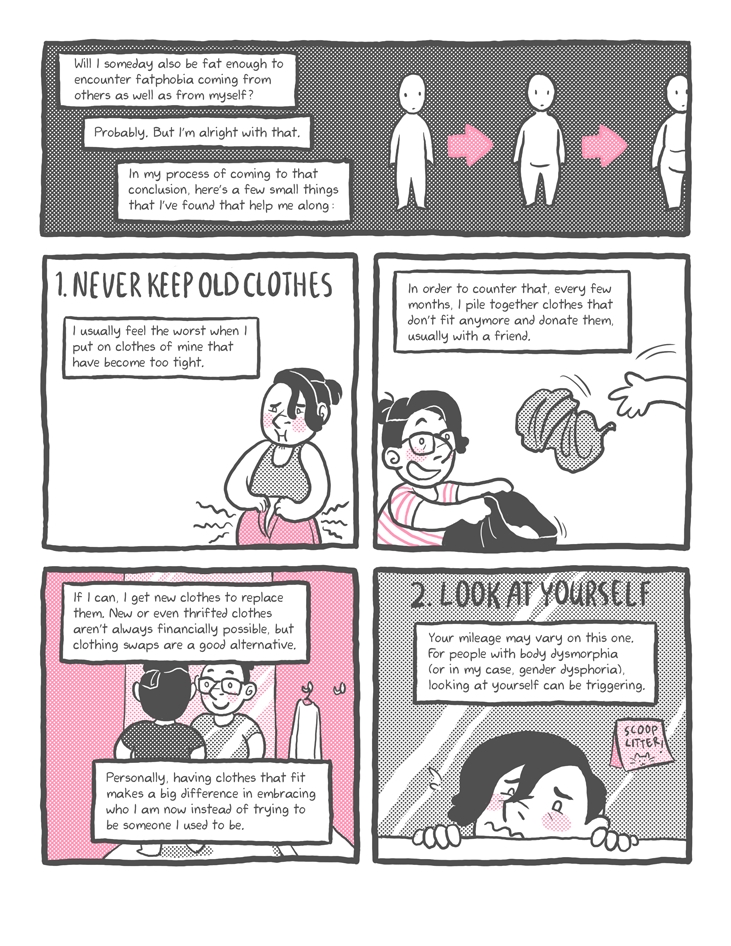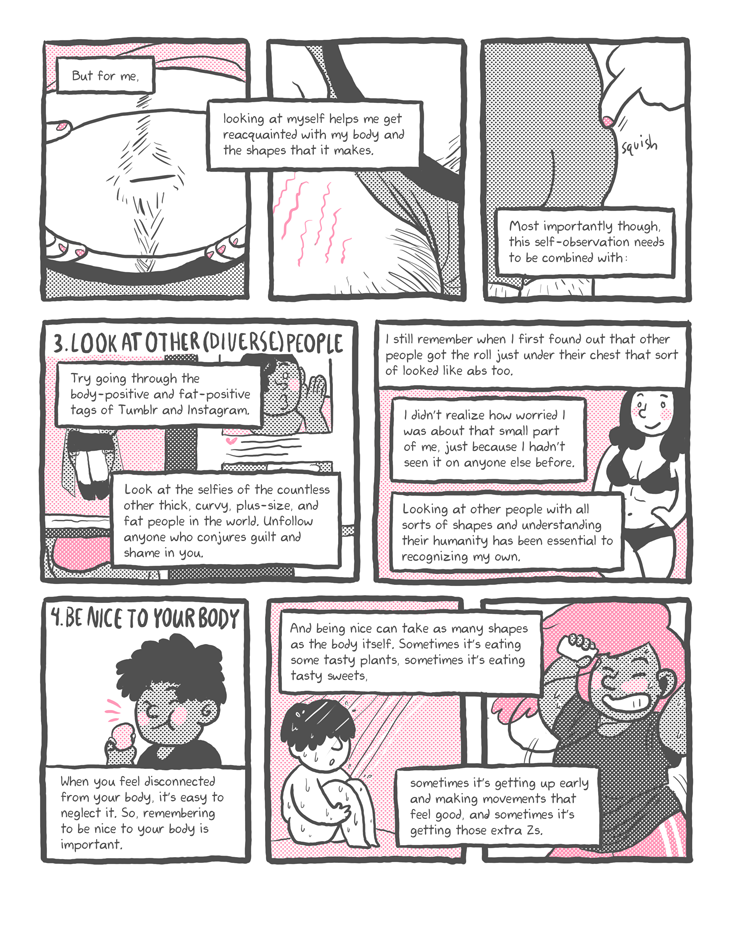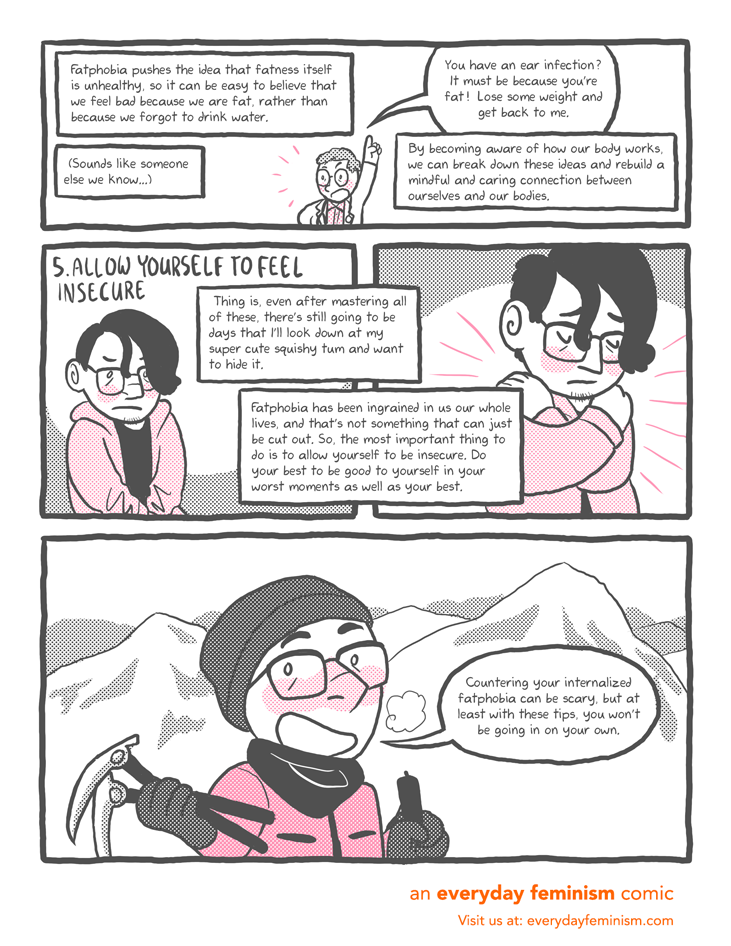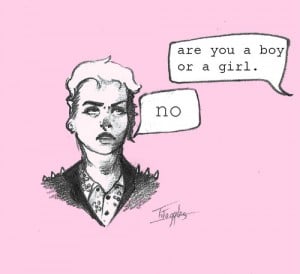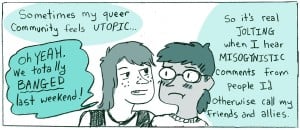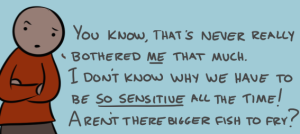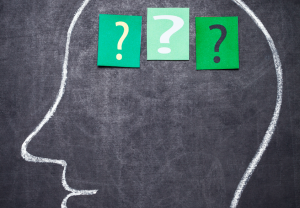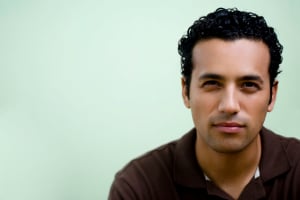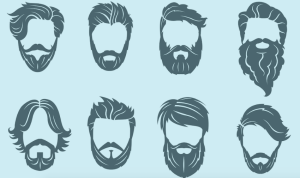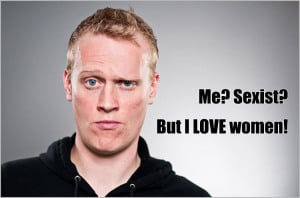Panel 1
(Three versions of Ronnie. First is child Ronnie, very tall for their age with thin limbs. Second is adolescent Ronnie, with visible hips but still thin. Third is college Ronnie, more squishy around the middle.)
Ronnie: For most of my life, I’ve been considered thin. I was considered tall and lanky as a kid and fairly average* throughout middle school and high school. Then during college, I started to slowly, but consistently, gain weight.
*Of course, my current size is the actual American average, not my previous sizes.
Panel 2
(Ronnie looking at their round stomach in a mirror, sweating nervously.)
Ronnie: At first, I didn’t realize what was happening to me. I thought I might be pregnant.
Panel 3
(Ronnie looks concerned up at two diagrams, one featuring a thin person and a fat person, each in the equation [Person]= [Thumbs up], the other with the equation [Thin Ronnie] = [Thumbs up], but [Fat Ronnie] = [Thumbs down])
Ronnie: After I understood that my rounder stomach was the result of fat deposits, I started to understand something else, too: Even as someone who was acquainted with and embraced body positivity, I still had a lot of internalized fatphobia. I just had never dealt with it because I was thin.
Panels 4-7
(Two panels feature Ronnie walking happily down a street on their own, unbothered, and Ronnie getting dressed for the day, their back facing the reader. Next to Ronnie getting dressed is a panel of another person of size with curly hair getting dressed, noise buzzing from their head. They look pained. The next panel shows the person walking down the street past a crowd of strangers, all emitting the same noise while the person tries to ignore them.)
Ronnie: With my clothes on, people still generally consider me thin. I don’t have strangers judging the food I eat or the clothes I wear. Doctors don’t insist that weight loss will fix my very real illnesses. Family and friends don’t tell me that I’ll be happier and have an easier time finding love when I’m thin. Because of this, I get the privilege of addressing my internalized bias about my body without hearing fatphobic comments from others. More often than not, people have been visibly of size for a while before they discover the body positivity movement, and have to deal with the constant body-policing and discrimination coming from others even as they’re trying to unlearn the shame and hatred of their body that they have been taught.
Panel 8
(Three figures stand next to each other, each progressively bigger and curvier, with arrows leading to the next in the progression. The last figure is cut off partially by the panel border.)
Ronnie: Will I someday also be fat enough to encounter fatphobia coming from others as well as from myself? Probably. But I’m alright with that. In my process of coming to that conclusion, here’s a few small things that I’ve found that help me along:
Panel 9
(Ronnie looking frustrated and ashamed as they try to button a pair of shorts that have become too small.)
Text: 1. Never Keep Old Clothes
I usually feel the worst when I put on clothes of mine that have become too tight.
Panel 10
(Ronnie holds out a trash bag while an outstretched arm throws a wad of clothing at it.)
Ronnie: In order to counter that, every few months, I pile together clothes that don’t fit anymore and donate them, usually with a friend.
Panel 11
(Ronnie looks happily in a mirror at a new outfit in a dressing room.)
Ronnie: If I can, I get new clothes to replace them. New or even thrifted clothes aren’t always financially possible, but clothing swaps are a good alternative. Personally, having clothes that fit makes a big difference in embracing who I am now instead of trying to be someone I used to be.
Panel 12
Text: 2. Look at Yourself
(Ronnie peeks over their dresser at themselves in the mirror, looking distressed. On the mirror is a sticky note reminding them to scoop the cat’s litter.)
Ronnie: Your mileage may vary on this one. For people with body dysmorphia (or in my case, gender dysphoria), looking at yourself can be triggering.
Panels 13-15
(Captions stretch across panels of Ronnie squishing their stomach, looking at the stretch marks on their hips, and poking their butt.)
Ronnie: But for me, looking at myself helps me get reacquainted with my body and the shapes that it makes. Most importantly, though, this self-observation needs to be combined with:
Panel 16
Text: 3. Look at Other (Diverse) People
(Image of social media feeds with multiple images of people posing, smiling, and making faces, each with a variety of shapes.)
Ronnie: Try going through the body-positive and fat-positive tags of Tumblr and Instagram. Look at the selfies of the countless other thick, curvy, plus-size, and fat people in the world. Unfollow anyone who conjures guilt and shame in you.
Panel 17
(Image of a model with a rounder stomach and fat deposits under her chest.)
Ronnie: I still remember when I first found out that other people got the roll just under their chest that sort of looked like abs too. I didn’t realize how worried I was about that small part of me, just because I hadn’t seen it on anyone else before. Looking at other people with all sorts of shapes and understanding their humanity has been essential to recognizing my own.
Panel 18-20
Text: 4. Be Nice to Your Body
(Caption spread across three panels. In one, someone eats a tasty peach. In another, someone sits on the floor of the shower, letting the water fall on them. In another, someone dances to a song on their phone, sweaty and happy.)
Ronnie: When you feel disconnected from your body, it’s easy to neglect it. So, remembering to be nice to your body is important. And being nice can take as many shapes as the body itself. Sometimes it’s eating some tasty plants, sometimes it’s eating tasty sweets, sometimes it’s getting up early and making movements that feel good, and sometimes it’s getting those extra Z’s.
Panel 21
Ronnie: Fatphobia pushes the idea that fatness itself is unhealthy, so it can be easy to believe that we feel bad because we are fat, rather than because we forgot to drink water. (Sounds like someone else we know…)
(A doctor holds up an authoritative and accusatory finger.)
Doctor: You have an ear infection? It must be because you’re fat! Lose some weight and get back to me.
Ronnie: By becoming aware of how our body works, we can break down these ideas and rebuild a mindful and caring connection between ourselves and our bodies.
Panel 20
Text: 5. Allow Yourself to Be Insecure
(Ronnie sits in a hoodie with messy hair with their arms crossed over their stomach, looking distracted and pained.)
Ronnie: Thing is, even after mastering all of these, there’s still going to be days that I’ll look down at my super cute squishy tum and want to hide it.
Panel 21
(Ronnie embraces themself, a small amount of warmth radiating from them.)
Ronnie: Fatphobia has been ingrained in us our whole lives, and that’s not something that can just be cut out. So, the most important thing to do is to allow yourself to be insecure. Do your best to be good to yourself in your worst moments as well as your best.
Panel 22
(Ronnie is standing before a mountain, turning back towards the reader, offering a set of mountaineering tools.)
Ronnie: Countering your internalized fatphobia can be scary, but at least with these tips, you won’t be going in on your own.
